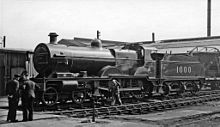- Midland Railway 1000 Class
-
Midland Railway 1000 Class 
Power type Steam Designer Samuel Waite Johnson: renewed as superheated Deeley compound by Henry Fowler Build date original: 1902; Renewal: 1914 Total produced 45 Configuration 4-4-0 UIC classification 2′B hv3 Gauge 4 ft 8 1⁄2 in (1,435 mm) Driver diameter 7 ft 0 in (2.134 m) Fuel type Coal Boiler pressure 220 psi (1.52 MPa) Cylinders Three, one inside high-pressure, two outside low-pressure High-pressure
cylinder size19 × 26 in (483 × 660 mm) Low-pressure
cylinder size21 × 26 in (533 × 660 mm) Valve gear Stephenson Valve type HP: piston valve,
LP: slide valvesTractive effort 21,840 lbf (97.1 kN) Class 1000 Power class 4P Midland Railway 1000 Class is a class of 4-4-0 steam locomotive designed for passenger work.
Contents
Overview
These were developed from a series of five locomotives (2631–2635) introduced in 1902 by Samuel W. Johnson which had had a 3-cylinder compound arrangement on the Smith system with one high pressure inside cylinder and two low pressure outside cylinders plus Smith's starting arrangement, reinforced working and for the first two locomotives, independent control of high-pressure and low-pressure valve gears. From 1905 onwards, Johnson's successor Richard Deeley built an enlarged and simplified version, eliminating all the Smith refinements whilst fitting his own starting arrangement, making the engines simpler to drive. These locomotives were originally numbered 1000–1029, but in the 1907 renumbering scheme the five Smith/Johnson locomotives became 1000–1004 and the Deeley compounds 1005–1034, ten more of these being added in 1908–1909. The original Johnson locomotives were all subsequently renewed as Deeley compounds including the now-preserved 1000 in 1914 which was outshopped with a superheater by the same occasion.
Numbered 1000–1044 by both the Midland and LMS companies, British Railways renumbered the Midland series of compounds 41000–41044 after nationalisation in 1948.
Preservation
No. 1000 was set aside for preservation after withdrawal and restored in 1959 close to its 1914 condition, painted in Midland maroon livery, running enthusiasts' specials until placed in the temporary Clapham Transport museum. Though steamed since preservation, it is currently a static exhibit at the Scottish Railway Preservation Society at Bo'ness, having been lent by the National Railway Museum in York.
For terminology, see Steam locomotive components
LMS compound locomotives
After the grouping, the LMS continued to build slightly modified MR Compounds as the LMS Compound 4-4-0
Other compound locomotives with the same 3-cylinder layout
- 3101 (later 3395) mixed traffic 2-6-0 prototype built 1887 for the French Nord Railway to the design of Edouard Sauvage - withdrawn in 1929
- NER Class 3CC number 1619 of the North Eastern Railway 4-4-0 express locomotive rebuilt in 1898 from a 2-cylinder compound. This was W.M. Smith's first application of his patent compound system.
- Four Robinson 4-4-2 Atlantic locomotives, classes 8D and 8E, built 1905–1906 as Smith compounds for the British Great Central Railway.
- One 4-6-2 locomotive (No. 900) built by the North British Locomotive Company for the Cape Government Railway in South Africa.
- Five 4-4-0 locomotives (GNRI Class V) designed by G.T Glover and built in 1932 for the Great Northern Railway (Ireland). These used the Deeley starting arrangement.
- André Chapelons 4-8-4 SNCF 242 A 1
Sources
- Ian Allan ABC of British Railways Locomotives, 1948 Edition, part 3, pp 5-6
- Nock O.S. (1964), "The Midland Compounds"; David & Charles, Dawlish, U.K.
- van Riemsdijk, John (1994). Compound Locomotives. Penryn, UK: Atlantic Transport Publishers. - Relevant pages: 25-32.
External links
Categories:- Midland Railway locomotives
- 4-4-0 locomotives
- Compound locomotives
- Railway locomotives introduced in 1902
Wikimedia Foundation. 2010.

